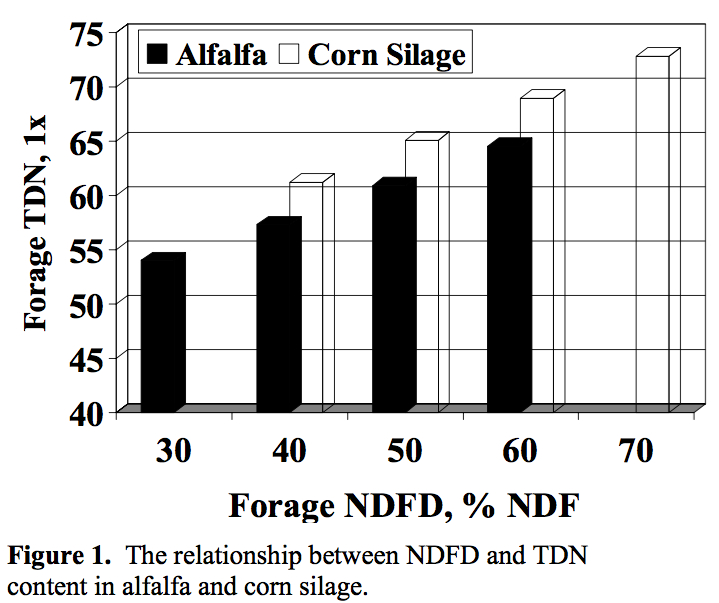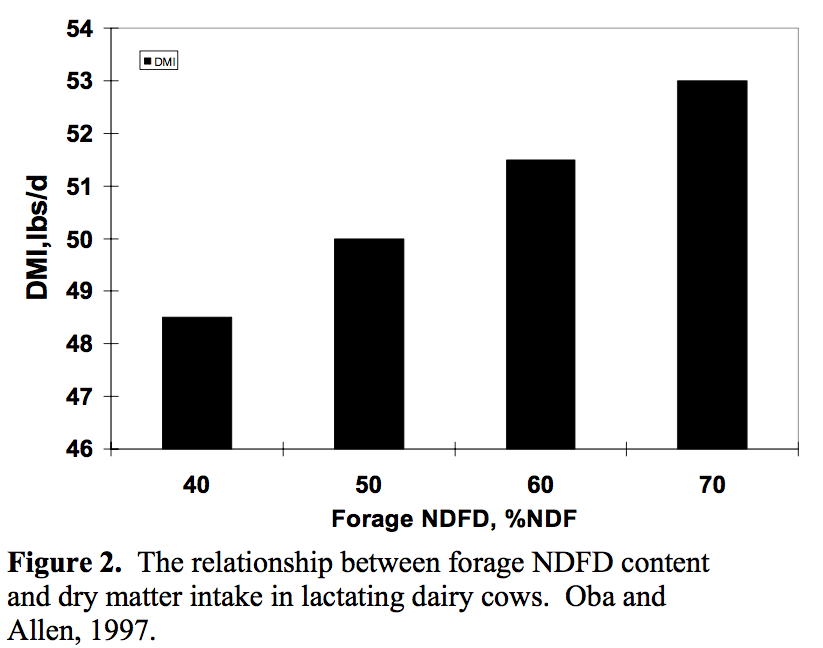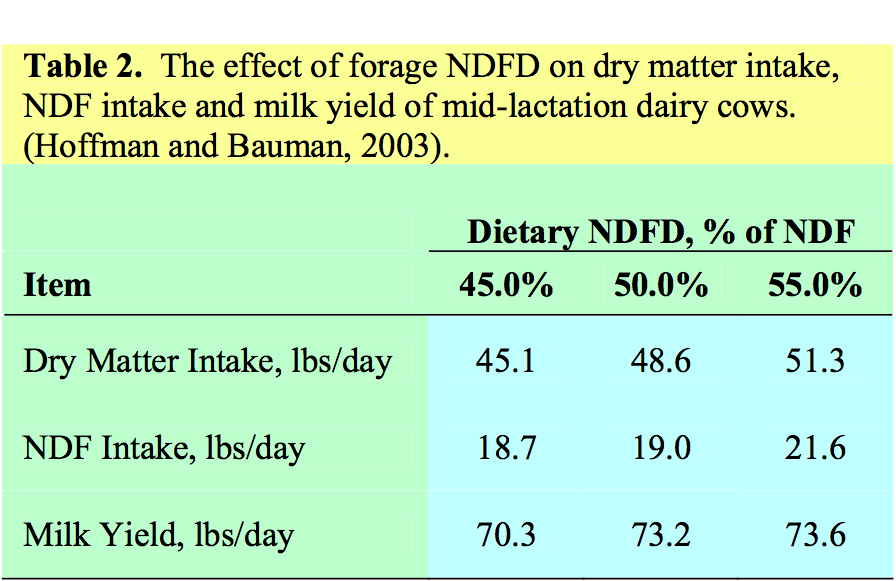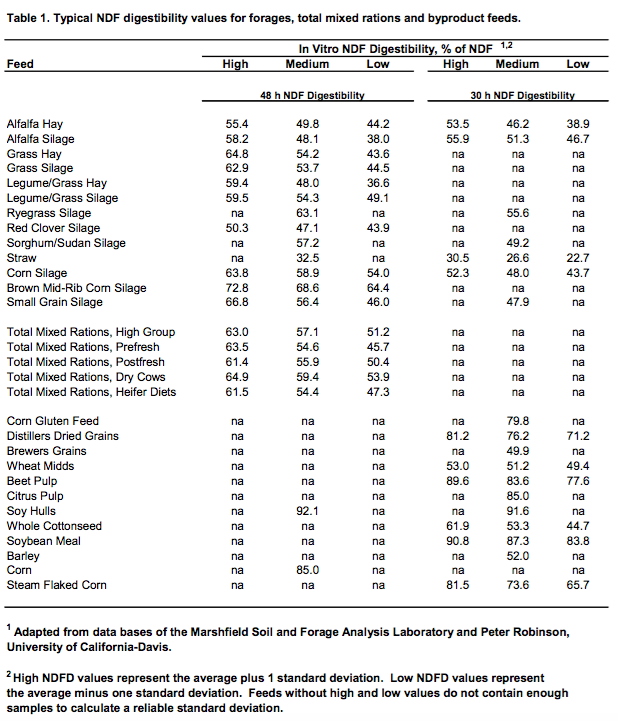Using NDF Digestibility in Ration Formulation
by Patrick Hoffman and David Combs
Introduction
This Focus on Forage article will attempt to address issues of NDF digestibility (NDFD) in forages and total mixed rations (TMRs). The utility of NDFD in dairy cattle nutrition programs will also be discussed.
How is NDFD measured?
Forage NDFD is expressed as a percentage of total NDF (NDFD, % of NDF), and can be measured or estimated in one of three ways. First, forages can be placed in small dacron bags and inserted into the rumen of a cow via a ruminal cannula for a specific period of time (usually 48 hours). The amount of NDF prior to ruminal incubation is compared to the amount of NDF remaining after ruminal incubation and NDFD is calculated. This is called an in situ method. The in situ method is a viable method to estimate NDFD of forage NDF and is often used in research and other forage evaluation programs. It is not routinely used by commercial forage testing laboratories because of the need for cannulated cows, the time needed to conduct the assay and the expense of the procedure.
Another approach is to estimate NDFD based on the forage lignin content. This is the approach the NRC, 2001 Nutrient Requirements of Dairy Cattle uses to predict NDFD. Lignification within a plant species is negatively associated with NDF digestibility and lignin can be directly measured by laboratory procedures that do not require rumen fluid. It should be noted however that laboratory determination of lignin is an arduous procedure and is susceptible to considerable laboratory error. The relationship between lignin and NDF digestibility also differs between forage species and is also affected by forage maturity and the environmental conditions that the forage was grown under. Recently California researchers (Robinson, et al., 2004) evaluated the NRC, 2001 lignin model to estimate NDFD and found a poor relationship between NDFD as estimated by lignin and in vitro NDFD content of feeds. In addition Robinson et al, 2004 found a better relationship between in vitro NDFD (as compared to using lignin to estimate NDFD) and in vivo digestibility in sheep. Other researchers (Jung et al 1997) have also found weak relationships between acid detergent lignin and in vivo NDFD in sheep for C4 grasses such as corn silage.
A third method for estimating NDFD is an in vitro procedure. A buffer and rumen fluid is added to a forage sample, and the mixture is allowed to ferment several hours. The digestibility of NDF is then measured as the difference between the amount of NDF in the forage before and after the in vitro fermentation. At present 30 or 48 hr in vitro NDFD determination is playing a larger role in estimating NDF digestibility for forages and diet energy predictions as compared to using lignin as a marker of NDFD. Some laboratories have reduced the incubation times from 48 hr to 30 or 24 hr. The rational is that shorter incubation times better describe the digestion potential of NDF in high producing lactating dairy cows. Reducing the incubation time of the in vitro NDFD assay to 30 or 24 hr is somewhat logical because feed is not retained in the rumen of a high producing dairy cow for 48 hr. The recommendation of a 48 hr NDFD value by the NRC, 2001, is to facilitate calculating TDN content of forages at maintenance intakes (which is TDN). While it can be argued that 30 hr in vitro NDFD values may better represent in vivo NDFD at maintenance the pragmatic issue with NDFD at this time is for laboratories to report forage NDF digestibilities that have a common scale and reference so the dairy industry can comprehend their meaning. It should be understood that a 48 hr in vitro NDFD value for a forage may not predict the absolute NDF digestibility in a high producing cow, but rather the NDF digestibility values of two forages can be compared. Thus an NDFD for forage that differs significantly from an average NDFD value for a specific forage can be used to troubleshoot a diet. Because the NRC, 2001 advises the use of a 48 hr in vitro NDF digestibility procedure to calculate TDN contents of forages at maintenance intakes, it is logical to identify with a 48 hr NDFD reference but 30 hr in vitro NDFD values can be used as long as the user is well versed in the system and the energy predictions it produces.
Listed in Table 1 are common 30 and 48 hr in vitro NDFD (% of NDF) values for forages, byproducts and total mixed rations. These values can be used as reference values to aid interpretation of NDFD values received on individual forage, byproducts or total mixed rations from the laboratory.
 What is the utility of NDF digestibility?
What is the utility of NDF digestibility?
There are two primary reasons why forages and total mixed rations are evaluated for NDFD. First, NDFD is used in summative equations to estimate energy content of forages. The NDFD content of forage can have a large impact on the energy value of the diet. As the NDFD content of alfalfa and corn silage increases {other nutrients (e.g. CP, NDF, ash, fat etc) are constant} the TDN content of the forage increases Figure 1. An increase in forage TDN content results in an increase in dietary energy content and potential milk yield. Second, in a review of recent research Oba and Allen, 1997 defined that a 1 unit rise in NDFD content in the diet results in a .37 lb./day rise in dry matter intake (Figure 2).  Thus changing NDFD in the forage base of diets results in a dual mechanism whereby energy intake is increased. Simply lactating dairy cows will consume more forage which is of a higher energy content when forages are high in NDFD.
Thus changing NDFD in the forage base of diets results in a dual mechanism whereby energy intake is increased. Simply lactating dairy cows will consume more forage which is of a higher energy content when forages are high in NDFD.
Recently we (Hoffman and Bauman, 2003) evaluated these concepts in trial with lactating dairy cows (Table 2). Early-mid lactating dairy cows were fed diets containing red clover augmented with normal corn silage or brown mid-rib corn silage. The feeding strategies resulted in diets with forage bases that  differed in NDFD content (approximately 45.0, 50.0 and 55.0 % of NDF). As described by Oba and Allen, 1997, we observed that cows ate more dry matter (DM) and produced more milk when fed forages that had a higher NDF digestibility. Of particular interest is cows exhibited a marked increase in NDF intake (Table 2) which is logical because as NDFD is improved NDF is digested more quickly in the rumen which in turn allows cows to consume more dry matter (or NDF).
differed in NDFD content (approximately 45.0, 50.0 and 55.0 % of NDF). As described by Oba and Allen, 1997, we observed that cows ate more dry matter (DM) and produced more milk when fed forages that had a higher NDF digestibility. Of particular interest is cows exhibited a marked increase in NDF intake (Table 2) which is logical because as NDFD is improved NDF is digested more quickly in the rumen which in turn allows cows to consume more dry matter (or NDF).
Are rations balanced for NDFD?
In most cases rations are not directly balanced for NDFD. The best way to perceive NDFD is that it is a measure of the digestion coefficient for NDF. We usually balance diets for total NDF but not the digestibility of NDF. This is similar to the way we balance diets for CP or fat but not the digestion coefficients for CP or fat. The challenge is that NDF makes up a larger proportion of the cow’s diet than protein or fat, and NDF digestibility is more variable than protein or fat digestibility. Ideally we would balance diets for total energy (NEL or TDN) by adjusting energy contributions from fiber, fat, protein and non-fiber carbohydrate by their respective digestibility coefficients, but we do not have routine lab methods available that will allow us to do this. We do care about NDFD because as the NDF digestion coefficient changes the dietary energy contribution from NDF changes. A second reason we do not balance rations for NDFD is because it is generally slow and quite expensive to get NDFD values on all of the feeds in a diet. The NDFD values for all forages, grains and protein supplements, etc., would have to be evaluated for NDFD etc. This is the reason that laboratory evaluation of TMRs for NDFD has become so popular. The NDFD of the entire ration which includes all of the feeds can be evaluated once for NDFD providing excellent insight for trouble-shooting NDFD problems in the diet. A present NDFD should be considered more of an energy prediction/ration troubleshooting tool as compared to a ration balancing nutrient.
How is NDFD used as a ration trouble-shooting tool?
First low NDFD in forages are mainly of concern in diets of high producing lactating dairy cows. Other classes of dairy cattle such as dry cows and heifers can utilize forages that may be lower in NDFD. Similarly, other ruminants such as beef cows and ewes do not have high energy demands and low NDFD forages can work well into their management system. Because high producing dairy cows are often in negative energy balance forages and diets low in NDFD that have the potential to limit feed or energy intake are of concern.
After forage has been evaluated for NDFD look at the value and compare your NDFD value to typical NDFD values for that species of forage (Table 1). Remember to make sure and compare in vitro NDFD values that were generated from the same incubation times (30, 48 hr etc). For example alfalfa silage and corn silage were evaluated for NDFD at 48 hr and the results were 40.0 and 50.0 % of NDF respectively. Both values are relatively low (Table 1) within their respective forage species. These values should suggest that dry matter intake, milk yield or body condition of high producing dairy cows may not be as desired. Because the analytical process of determining NDFD is not perfect the results of the forage test should be compared to animal observations. If forage test and animal observations agree and suggest NDFD of the forage base is low dairy producers and nutritionist might consider running and NDFD test on the TMR if a TMR is fed to further confirm the status of dietary NDFD.
What can be done if forages or diets are low in NDFD?
When the forage base of a diet fed to high producing dairy cows is low in NDFD dietary energy is usually the primary limitation. In most situations supplementing more grain or fat in the diet to improve the energy density of an early lactation diet is not feasible because the maximum amount of grain or fat may already be included in the diet. If not, some additional grain or fat can be added to improve energy status.
In most situations there are two preferred management strategies to improve a lactating cow diet in which the forage base has low NDFD. First, if possible, the low NDFD forages can be replaced with forages that are higher in NDFD. This management strategy is only effective if forages truly higher in NDFD are available and accessible in the forage inventory. In many situations the forage inventory is not flexible enough to implement this strategy. When the forage inventory can not be changed the amount of low NDFD forage fed can be decreased and replaced with byproducts that are high in NDFD. This is often a very effective management strategy. Byproducts that are high in NDF and NDFD such as soyhulls, beet pulp and in some situations citrus pulp should be considered because of their potential to replace some of the lower digestible NDF in the ration with a source of NDF that is more rapidly and completely digested (Table 1)
It should be remembered that not all byproducts are high in NDFD (Table 1). For example, byproduct feeds such as cottonseed or wheat midds do not have high NDFD potential. When low NDFD forages are replaced with high NDFD byproducts the response time of cows in dry matter intake or milk yield should be relatively short 5-10 days if a true change in dietary energy status was made. Therefore supplementation strategies should be tried and evaluated short-term before making long-term changes in feed supplies and inventories.
Can NDFD in forages be too high?
Little is known or understood about whether NDFD in forages or diets can be too high. It is possible that NDFD can be predicted too high in relationship to true energy available at maintenance when 48 hr in vitro measurements are used. This would be especially true for early maturity grasses. If forages bases have extremely high NDFD the forages should be fed under normal ration guidelines. Diets should be monitored for particle length and animals monitored for any undesirable responses such as low fat test, excessive weight gain, or lower than predicted intake. If such animal responses are noted it may be feasible to reduce the proportion of grain and increase the proportion of forage in the diet.
References
Hoffman, P. C., and L. M. Bauman. 2003. Strategies to improve milk yield of lactating dairy cows fed red clover silage. Prof. Anim. Sci. 19:178-187.
National Research Council. 2001. Nutrient requirements of dairy cattle. 7th rev. ed. Natl. Acad. Sci., Washington DC.
Oba, M and M. Allen. 1997. Evaluation and the importance of the digestibility of neutral detergent fiber from forage. Effects on dry matter intake and milk yield in dairy cows. J. Dairy Sci. 82:589.
Robinson, P.H., D.I. Givens, and G. Getachew. 2004. Evaluation of NRC, UC Davis and ADAS approaches to estimate values of feeds at maintenance energy intake from equations utilizing chemical assays and in vitro determinations. Anim. Sci. Feed. Tech. 114:75-90.
Focus on Forage – Vol 6: No. 3
© University of Wisconsin Board of Regents, 2004
Patrick C. Hoffman, Extension Dairy Specialist
UW-Madison Dairy Science Department
Marshfield Agricultural Research Station
pchoffma@wisc.edu
David K. Combs, Dairy Scientist
University of Wisconsin – Madison
dkcombs@wisc.edu






